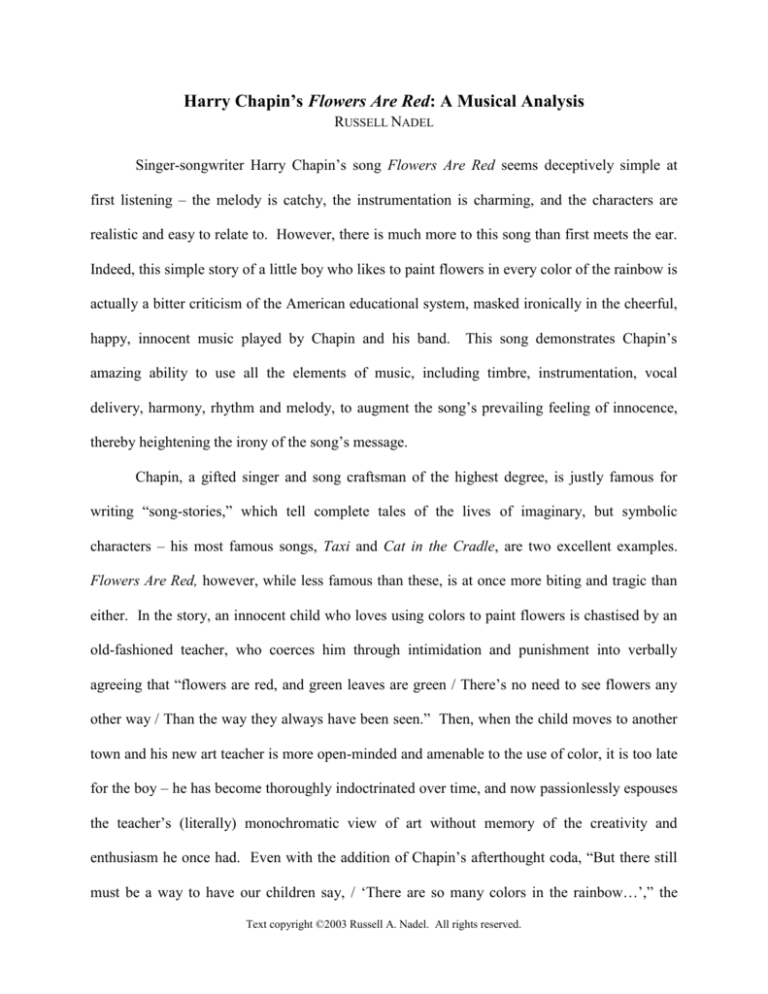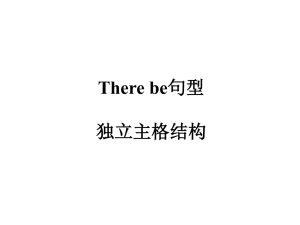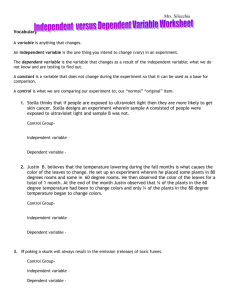
Harry Chapin’s Flowers Are Red: A Musical Analysis
RUSSELL NADEL
Singer-songwriter Harry Chapin’s song Flowers Are Red seems deceptively simple at
first listening – the melody is catchy, the instrumentation is charming, and the characters are
realistic and easy to relate to. However, there is much more to this song than first meets the ear.
Indeed, this simple story of a little boy who likes to paint flowers in every color of the rainbow is
actually a bitter criticism of the American educational system, masked ironically in the cheerful,
happy, innocent music played by Chapin and his band.
This song demonstrates Chapin’s
amazing ability to use all the elements of music, including timbre, instrumentation, vocal
delivery, harmony, rhythm and melody, to augment the song’s prevailing feeling of innocence,
thereby heightening the irony of the song’s message.
Chapin, a gifted singer and song craftsman of the highest degree, is justly famous for
writing “song-stories,” which tell complete tales of the lives of imaginary, but symbolic
characters – his most famous songs, Taxi and Cat in the Cradle, are two excellent examples.
Flowers Are Red, however, while less famous than these, is at once more biting and tragic than
either. In the story, an innocent child who loves using colors to paint flowers is chastised by an
old-fashioned teacher, who coerces him through intimidation and punishment into verbally
agreeing that “flowers are red, and green leaves are green / There’s no need to see flowers any
other way / Than the way they always have been seen.” Then, when the child moves to another
town and his new art teacher is more open-minded and amenable to the use of color, it is too late
for the boy – he has become thoroughly indoctrinated over time, and now passionlessly espouses
the teacher’s (literally) monochromatic view of art without memory of the creativity and
enthusiasm he once had. Even with the addition of Chapin’s afterthought coda, “But there still
must be a way to have our children say, / ‘There are so many colors in the rainbow…’,” the
Text copyright ©2003 Russell A. Nadel. All rights reserved.
subtext of this song is that a child – innocent, guileless, creative, and unadulterated by stodgy
adult ideas of black and white or right and wrong – is at first resistant to those ideas, but is forced
to accept them by his closed-minded, joy-killing teacher. This eventually causes him to become
old and stodgy himself long before his time. This message, that the evil of uncreative education
is to blame for this boy’s loss of his unlimited, untapped creativity and potential, is a tragic one,
and a call to arms for education reformers and activists everywhere.
Flowers Are Red is also one of Chapin’s most musically subtle and effective songs.
While the full ensemble of Chapin’s band includes acoustic guitar, drums/percussion,
piano/synthesizer, bass guitar, three voices, cello, and electric guitar, the instruments are used
sparsely and effectively in an almost pointillistic fashion. The drummer, for example, plays only
rim shots, woodblock, and isolated cymbal hits throughout the piece (a rhythm which, with bare
piano and acoustic guitar accompaniment and the addition of a vocalist saying “rant, rant, rant,”
Chapin meaningfully calls “an education beat” [0:00-0:20]).
The cello, electric guitar and
synthesizer are reserved almost exclusively for brief, wailing instrumental solos between
choruses that might be symbolic of the child’s loss of innocence (1:21-1:28, 2:08-2:19, and 3:063:16). The piano is used playfully, adding swingy, pointillistic ornamentations to the texture,
especially in the form of three characteristic, joyful blips before the main chorus (ex. 1:08) –
these might represent the boy’s opening joie de vivre. Chapin also used timbre effectively in this
piece – the instrumentation becomes much thinner and more exposed during the boy’s final two
choruses, representing his acceptance of the teacher’s useless dogma, and becomes much thicker
and more aggressive during the following verse, foreshadowing the bitter results revealed in the
boy’s final chorus before the coda. The full ensemble only plays during the uplifting coda.
-2Text copyright ©2003 Russell A. Nadel. All rights reserved.
Analysis of Chapin’s vocal delivery becomes crucial when attempting to look for
subtextual meaning in this song. His vocal inflections throughout the course of the piece are
more than just evocative of the boy; they actually represent the boy’s mood and the progression
of his feelings. Chapin uses a thinner, reedy tone and simpler words when singing as the boy,
but modulates his tone to represent the boy’s happy enthusiasm at first (1:10-1:20), guileless
thought process during his punishment (2:32-2:47), hurt innocence at his acceptance of the
teacher’s edict (2:48-3:05), and finally his fully-accepting, “rote reciting” tone during his final
chorus (3:59-4:15). The first teacher is embodied in a very formal and haughty tone of voice,
affected of accent and speech, and overly moral (0:42-1:06), and the combination of a deep bass
voice and a high falsetto voice complements this portrayal effectively during her choruses.
Finally, the second teacher’s portrayed voice subtly combines the fun, childlike enthusiasm of
the boy at first, but still with the mature tones expected of an adult.
The simple melodies and harmonies of this song also complement Chapin’s two-layered
text. The boy’s choruses (ex. 1:09-1:21) are leapwise, expressive, and joyful, while the teacher’s
(ex. 0:55-1:06) are mostly stepwise, dour, sequential, and stuck in a small range. The teacher’s
lectures are also stuck in a very small melodic range, representing her closed-mindedness and
unwillingness to think “outside the box”. The simple harmonic structure of the music subtly
reinforces the subtext of the lyrics – while all the choruses are major, the narrative verses are
minor, using a 1-b7-b6-b7-1 ostinato bass line to set up the simple I-V-I harmonizations of the
choruses.
The rhythms and tempi of Flowers Are Red are also revealing, and have a layer of
meaning deeper than the surface might indicate. Rhythmically, it is interesting that the boy’s and
second teacher’s motives are played joyfully and swung, or in a sort of understated 12/8 meter,
-3Text copyright ©2003 Russell A. Nadel. All rights reserved.
while the first teacher’s are played emotionlessly and very straight indeed (in firm 4/4 time).
The child’s last chorus before the coda (3:58-4:15), however, is sung straight, and combines the
child’s reedy tone of voice and speech sloppiness with the teacher’s lecturing tone. Although
this last chorus is in a major key, if heard in the context of the song’s subtext, it becomes a
crushing revelation of the depth of the boy’s conversion to senseless grown-up dogma. All this
is backed up by the tempi of the piece, as well – the main body of the piece is in a jaunty allegro
time, but slows to a crawl for the child’s two “Flowers are red” choruses (2:38, 3:50), and stops
altogether for the charming “and he said” repetitions before the same two choruses. This tempo
stop is obviously paralleled by the final tempo stop just before the coda (4:15), during which
Chapin says, “But there still must be a way…” In this way, Chapin used tempo to complement
the mood of each downtrodden moment, and thereby gave himself an opportunity to redeem an
otherwise depressing song with the (ironic?) look-to-the-future coda.
Flowers Are Red is an important song, especially for students, educators, and anyone who
has ever had a bad experience with an uninspired or creativity-killing teacher (everyone). Its
lyrics represent a vivid call to arms and to education reform, without using any revolutionary
language or political rhetoric, and its music complements this subtext in a very subtle, but
effective and inspiring way. This is, in short, the best kind of protest song – effective, to the
point, incisive, personal, and thoughtful, and without the inflationary and sometimes grating
moods and morals. This should be in every teacher’s personal audio library, as an inspiration for
what a good teacher can be – and a warning reminder of the lasting results of closed-mindedness.
-4Text copyright ©2003 Russell A. Nadel. All rights reserved.
Lyrics to Harry Chapin’s Flowers Are Red (orig. released on Living Room Suite, 1978)1
(“Rant, rant, rant, rant, rant, rant” – It’s an education beat.)
The little boy went first day of school
He got some crayons and started to draw
He put colors all over the paper
For colors was what he saw
And the teacher said, “What you doin’ young man?”
“I'm paintin’ flowers,” he said
She said, “It's not the time for art young man
And anyway flowers are green and red
There’s a time for everything young man
And a way it should be done
You’ve got to show concern for everyone else
For you're not the only one”
And she said,
“Flowers are red young man
Green leaves are green
There's no need to see flowers any other way
Than the way they always have been seen”
But the little boy said,
“There are so many colors in the rainbow
So many colors in the morning sun
So many colors in the flower and I see every one”
Well the teacher said, “You’re sassy
There’s ways that things should be
And you'll paint flowers the way they are
So repeat after me,” And she said,
“Flowers are red young man
Green leaves are green
There's no need to see flowers any other way
Than the way they always have been seen”
But the little boy said,
“There are so many colors in the rainbow
So many colors in the morning sun
So many colors in the flower and I see every one”
1
Lyrics ©1996-2002 Harry Chapin, taken from www.harrychapin.com; album information from www.allmusic.com.
-5Text copyright ©2003 Russell A. Nadel. All rights reserved.
The teacher put him in a corner
She said, “It’s for your own good”
And you won't come out ‘til you get it right
And are responding like you should”
Well finally he got lonely
Frightened thoughts filled his head
And he went up to the teacher
And this is what he said… and he said,
“Flowers are red, green leaves are green
There’s no need to see flowers any other way
Than the way they always have been seen”
Well, time went by like it always does
And they moved to another town
And the little boy went to another school
And this is what he found
The teacher there was smiling
She said, “Painting should be fun
And there are so many colors in a flower
So let’s use every one”
But that little boy painted flowers
In neat rows of green and red
And when the teacher asked him why
This is what he said… and he said,
“Flowers are red, green leaves’r green
There’s no need to see flowers any other way
Than the way they always have been seen.”
But there still must be a way to have our children say,
“There are so many colors in the rainbow
So many colors in the morning sun
So many colors in the flower and I see every one”
-6Text copyright ©2003 Russell A. Nadel. All rights reserved.









